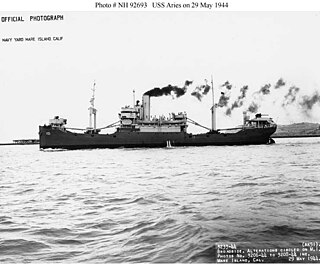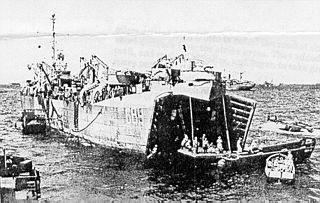Fifteen ships of the Royal Navy have been named HMS Enterprise while another was planned:
USS Grampus may refer to:
Five ships of the United States Navy have been named Catawba, after the Catawba River of North Carolina.
Six ships of the United States Navy have borne the name USS Powhatan or USNS Powhatan, named in honor of Powhatan (1550–1618), an Indian chief in tidewater Virginia; the father of Pocahontas.

USS Sara Thompson (SP-3148/AO-8) was a tanker in the United States Navy. She was purchased at the start of World War I by the U.S. Navy and served as a tanker supporting American troops in Europe. Post-war she operated in the Pacific Ocean, supporting Navy operations in the Guam, China, and the Philippines. Because of her age and deteriorating condition, she spent her final days in the US Navy as a receiving hulk in the Philippines.

USS Aries (AK-51) (1918–1952) was a United States Navy cargo ship built as Lake Geneva under a United States Shipping Board (USSB) contract in 1918 at Duluth, Minnesota, by the McDougall Duluth Shipbuilding Company, to augment American logistics capability during World War I. The freighter was delivered to the Navy at Montreal, Quebec, Canada, on 21 September 1918 and was placed in commission the following day for service in the Naval Overseas Transportation Service with Lieutenant Commander Francis A. Brannen, USNRF, in command. Aries was named for the constellation.
USS Terror may refer to the following ships operated by the United States Navy:

The second USS Puritan was a Puritan-class monitor in the United States Navy, constructed in 1882. She was the only ship in her class.

USS Rockford (PF-48), a Tacoma-class frigate in commission from 1944 to 1945, thus far has been the only ship of the United States Navy to be named for Rockford, Illinois. She later served in the Soviet Navy as EK-18 and in the Republic of Korea Navy as ROKS Apnokkang (62).

USS Chase County (LST-532) was an LST-491-class tank landing ship built for the United States Navy during World War II. Named after counties in Kansas and Nebraska, she was the only U.S. Naval vessel to bear the name.

USS Churchill County (LST-583), originally USS LST-583, was an LST-542-class tank landing ship built for the United States Navy during World War II and in commission from 1944 to 1946 and 1960 to 1968. Named for Churchill County, Nevada she was the only U.S. Navy vessel to bear the name.

USS Dodge County (LST-722) was an LST-542 class Landing Ship Tank, built for the United States Navy during World War II. She was renamed USS Dodge County on the first of July, 1955, for counties in Georgia, Minnesota, Nebraska, and Wisconsin, and was the only United States Navy vessel to bear the name.

USS LST-689 was an LST-542-class tank landing ship built for the United States Navy during World War II. Late in her career she was renamed Daggett County (LST-689)—after Daggett County, Utah, the only U.S. Naval vessel to bear the name—but never saw active service under that name.
USS Indicative (AM-250) was an Admirable-class minesweeper built for the United States Navy during World War II and in commission from 1944 to 1945. In 1945, she was transferred to the Soviet Union and served in the Soviet Navy as T-273. The Soviets converted her into a naval trawler in 1948 and renamed her Tsiklon.
Six ships of the United States Navy have been named USS Kanawha and one has been named USS Kanawha II:

USS Pembina (AK-200) – later known as USNS Pembina (T-AK-200) -- was an Alamosa-class cargo ship that was constructed for the U.S. Navy during the closing period of World War II. She supported the end-of-war Navy effort and was subsequently placed in service with the US Army under the Shipping Control Authority for the Japanese Merchant Marine with a Japanese crew in Yokosuka, Japan.

USS Maple, was a lighthouse tender that served in the United States Navy from 1893 to 1899, seeing service as an auxiliary ship during the Spanish–American War in 1898, and from 1917 to 1919, operating as a patrol vessel during World War I. She also served as USLHT Maple in the United States Lighthouse Board fleet from 1899 to 1910 and in the United States Lighthouse Service from 1910 to 1933.

USS Raeo (SP-588) was a United States Navy patrol vessel in commission from 1917 to 1919. Prior to her U.S. Navy service, she operated as the motor passenger vessel Raeo from 1908 to 1917. After the conclusion of her U.S. Navy career, she served as the fishery patrol vessel USFS Kittiwake in the United States Bureau of Fisheries fleet from 1919 to 1940 and as US FWS Kittiwake in the Fish and Wildlife Service fleet from 1940 to 1942 and from 1944 to at least 1945, and perhaps as late as 1948. During World War II, she again served in the U.S. Navy, this time as the yard patrol boat USS YP-199. She was the civilian fishing vessel Raeo from 1948 to 1957, then operated in various roles as Harbor Queen from 1957 to 1997. She became Entiat Princess in 1998 and as of 2009 was still in service.
HMS St. Helena (K590) was a Colony-class frigate of the United Kingdom that served during World War II. She originally was ordered by the United States Navy as the Tacoma-class patrol frigateUSS Pasley (PF-86) and was transferred to the Royal Navy prior to completion. After the British returned her to the United States in 1946, she briefly carried the name USS St. Helena (PF-86).
USS Torry (AKL-11) was a Camano-class cargo ship of the United States Navy. During World War II, she previously served as the United States Army Transport FS-394. After being acquired by the United States Navy, the ship was commissioned as USS Torry (AG-140), but was later reclassified as a light cargo ship. On 29 January 1952, she was transferred to the Department of the Interior and was sold to Socony-Mobil in 1961. The ship was successively sold to several companies before becoming a fishing vessel and was scuttled in 2015 off the coast of Delaware as an artificial reef.
This page is based on this
Wikipedia article Text is available under the
CC BY-SA 4.0 license; additional terms may apply.
Images, videos and audio are available under their respective licenses.










